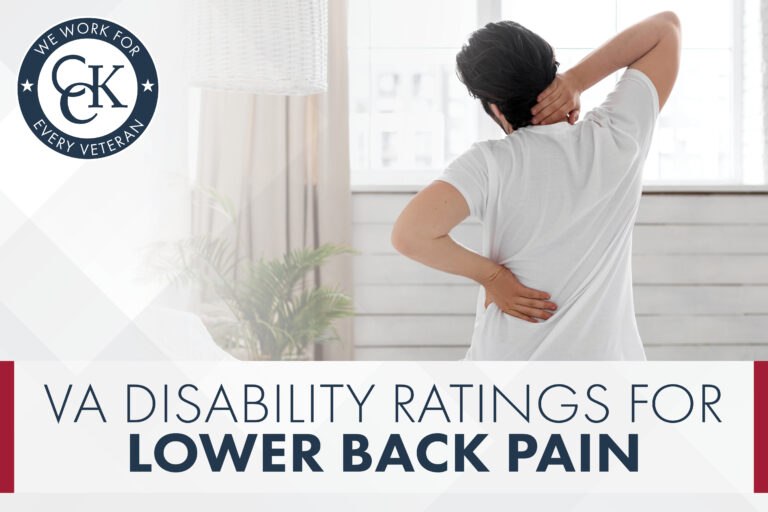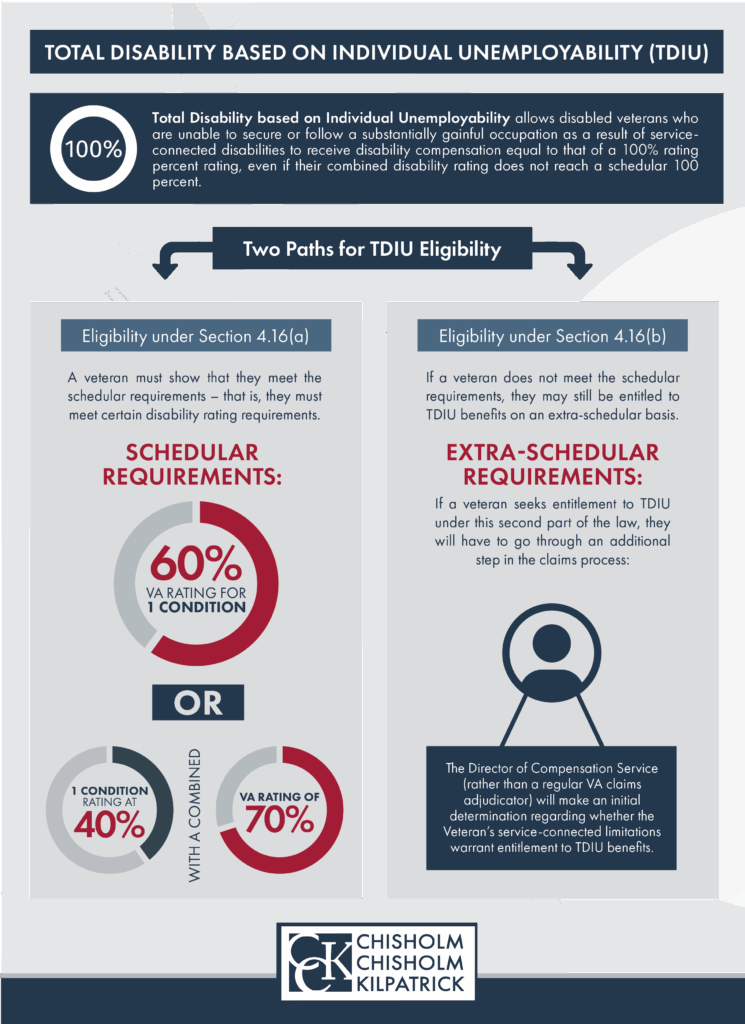VA Disability Ratings for Lower Back Pain

CCK Law: Our Vital Role in Veterans Law
Veterans frequently experience low back pain following service. Low back conditions, depending on their severity, can significantly impact a veteran’s ability to live normal lives or carry out work-related responsibilities. But if a veteran can prove that their back condition is connected to their military service, they may be eligible to receive a VA rating for back pain, which means monthly compensation and other benefits.
This article will explore various VA ratings for back pain, as well as methods you can use to potentially increase your rating.
Highlights of this article include:
- The VA disability ratings that veterans can earn for low back pain
- Explanations of how to establish service connection for low back pain
- How compensation is calculated for VA ratings for back pain
- Strategies to help you achieve the correct VA rating for back pain
- And more
How to Prove Back Pain is Service Connected
Service connection is the acknowledgment by VA that a veteran’s current health condition is related to their military service. There are several ways in which veterans can establish service connection for their back pain, including the following:
Direct Service Connection
Generally, to establish direct service connection, veterans must show that their diagnosed medical condition or injury resulted from or was worsened by a specific event in their military service. Therefore, veterans must show evidence of the following three things:
- A current diagnosis of a back condition;
- An in-service event, injury, or illness; and
- A medical nexus (i.e., link) between the current, diagnosed back condition and the in-service event, injury, or illness.
VA typically requires an opinion from a medical expert stating that your back injury likely resulted from an in-service event. VA will likely schedule a Compensation and Pension (C&P) exam to fulfill this nexus element.
Secondary Service Connection
Veterans can also be service-connected for back conditions on a secondary basis. This means that the back condition is the result of an already service-connected condition, rather than directly caused by service. To prove secondary service connection, medical evidence must link their back pain to their already service-connected condition.
For example, a veteran may have a service-connected hip condition that causes them to favor one side when walking, resulting in an altered gait. Over time, the veteran develops low back pain, and a doctor determines the veteran’s altered gait is the cause. Therefore, the veteran should be able to file a successful claim for their lower back pain on the basis of secondary service connection.
Low back pain can also lead to other conditions. Learn more about VA Secondary Conditions to Back Pain.
What Evidence Should I Submit to VA for a Low Back Pain Disability Rating?
To establish service connection and receive a VA rating for back pain, it is important to be mindful of the evidence you submit to VA. Some of the most important evidence a veteran should submit include:
- Official Service Records – Typically, these records will take the form of documentation of an in-service injury or event that contributed to your current back pain. These can be Personnel Records, Service Medical Records, Certificates of Discharge, and more.
- Treatment Records – Medical records documenting your back pain diagnosis and treatment are also critical to receiving a VA rating. These can be VA Medical Records, Private Medical Records, or the individual medical opinions of your doctor.
In addition to these, lay statements from friends, family, and fellow servicemembers testifying to the seriousness of your low back pain can also provide valuable context to VA, even if they are not as important as official records.

Compensation and Pension (C&P) Exams for Back Pain
VA may also request that a veteran submit to a Compensation & Pension exam to observe their back pain symptoms firsthand. These C&P exams are typically administered by medical examiners who work for VA. When it comes to assigning a VA rating for back pain, a C&P exam might look like the following:
- At some point during the exam, the VA examiner will likely use a goniometer to measure how far the veteran can bend forward, backward, and side to side. These range of motion measurements can play a large part in determining the severity of the veteran’s back condition.
- During these range of motion tests, the examiner may also consider any functional loss caused by the veteran’s back condition, as evidenced by pain during motion. For instance, if a veteran is able to bend forward 85 degrees, but starts to experience serious pain at 55 degrees, the examiner may determine this a functional limitation and judge accordingly.
- The examiner may also ask the veteran questions about the impact their back condition has on their life. This might include questions about pain severity or mobility impairments when it comes to exercise, work, or even basic movement.
In addition to range of motion measurements and functional loss, VA examiners should also address the presence of flare-ups, or sudden and temporary increases in symptoms.
Flare-ups are recurrent (i.e., happening repeatedly) but unpredictable and arise without warning. The abrupt escalation in symptoms, including pain and loss of mobility, can sometimes result in additional loss or limitation of motion due to pain.
Per the Court of Appeals for Veterans Claims (CAVC) case Sharp v. Shulkin, VA examiners must offer an opinion on how the veteran could be functionally limited during a flare-up, even if the examination is not being performed during a flare-up. If they fail to do so, then the examination is inadequate for VA rating purposes, and a new examination may be warranted.

How VA Rates Low Back Pain
After you prove service connection for your back pain, VA will assign you a percentage rating that coincides with the severity of your condition. The monthly compensation you receive will be based on how high this rating is.
In most cases, VA uses the General Rating Formula for Diseases and Injuries of the Spine under 38 CFR § 4.71a to evaluate back conditions, including low back pain. This general rating formula is based primarily on range of motion, or the measurement of the amount of movement around a specific joint or body part. The range of motion measurement typically encompasses the range of flexion (i.e., bending) and extension (i.e., straightening).
General Rating Formula for Spine Conditions
- 100 percent – unfavorable ankylosis of the entire spine
- 50 percent – unfavorable ankylosis of the entire thoracolumbar spine
- 40 percent – unfavorable ankylosis of the entire cervical spine; or, forward flexion of the thoracolumbar spine 30 degrees or less; or, favorable ankylosis of the entire thoracolumbar spine
- 30 percent – forward flexion of the cervical spine 15 degrees or less; or, favorable ankylosis of the entire cervical spine
- 20 percent – forward flexion of the thoracolumbar spine greater than 30 degrees but not greater than 60 degrees; or, forward flexion of the cervical spine greater than 15 degrees but not greater than 30 degrees; or, the combined range of motion of the thoracolumbar spine not greater than 120 degrees; or, the combined range of motion of the cervical spine not greater than 170 degrees; or, muscle spasm or guarding severe enough to result in an abnormal gait or abnormal spinal contour such as scoliosis, reversed lordosis, or abnormal kyphosis
- 10 percent – forward flexion of the thoracolumbar spine greater than 60 degrees but not greater than 85 degrees; or, forward flexion of the cervical spine greater than 30 degrees but not greater than 40 degrees; or, combined range of motion of the thoracolumbar spine greater than 120 degrees but not greater than 235 degrees; or, combined range of motion of the cervical spine greater than 170 degrees but not greater than 335 degrees; or, muscle spasm, guarding, or localized tenderness not resulting in abnormal gait or abnormal spinal contour; or, vertebral body fracture with loss of 50 percent of more of the height.

Alternative Rating Approach for Low Back Pain: Intervertebral Disc Syndrome
Importantly, if veterans do not meet the range of motion criteria outlined above, it is still possible to obtain a high VA rating for back pain if they have intervertebral disc syndrome (IVDS) as well.
VA rates IVDS under Diagnostic Code 5243, which focuses on the number of incapacitating episodes veterans experience as a result of their low back pain. Here, VA defines an incapacitating episode as a period of acute signs and symptoms that requires bed rest as prescribed by a physician. IVDS is rated as follows:
- 60 percent – with incapacitating episodes having a total duration of at least 6 weeks during the past 12 months
- 40 percent – with incapacitating episodes having a total duration of at least 4 weeks but less than 6 weeks during the past 12 months
- 20 percent – with incapacitating episodes having a total duration of at least 2 weeks but less than 4 weeks during the past 12 months
- 10 percent – with incapacitating episodes having a total duration of at least one week but less than 2 weeks during the past 12 months
In this case, VA should apply the rating criteria that results in the higher evaluation for the veteran.
Can Veterans Receive Disability Benefits for Low Back Pain Alone? (Saunders v. Wilkie)
In short: Yes.
Generally, veterans need a current, diagnosed condition to qualify for VA disability compensation. It can be notoriously difficult to diagnose the exact medical reason for low back pain. As a result, one of the most frequently asked questions that we hear about low back pain is whether pain alone is enough to qualify.
Prior to April 2018, the Court of Appeals for Veterans Claims had held that pain alone—without a medical diagnosis of an underlying condition—was not compensable. But in Saunders v. Wilkie, the Federal Circuit ruled that if a veteran experiences back pain as a result of their military service, and the pain causes functional impairment of earning capacity, the veteran may still be eligible to receive VA disability compensation, even if they do not have an actual diagnosis identifying the cause.
The Saunders decision can benefit both veterans seeking service connection and those seeking increased ratings for their back pain.
VA Compensation for Lower Back Pain
Generally, the higher your VA rating for back pain, the more compensation you will receive. Consult the chart below to see the 2025 payment rates VA assigns depending on the seriousness of your disorder.
As of 2025, the VA disability rate benefit amounts are as follows:
- 0 percent disability rating: $0.00 per month
- 10 percent disability rating: $175.51 per month
- 20 percent disability rating: $346.95 per month
- 30 percent disability rating: $537.42 per month
- 40 percent disability rating: $774.16 per month
- 50 percent disability rating: $1,102.04 per month
- 60 percent disability rating: $1,395.93 per month
- 70 percent disability rating: $1,759.19 per month
- 80 percent disability rating: $2,044.89 per month
- 90 percent disability rating: $2,297.96 per month
- 100 percent disability rating: $3,831.30 per month
In addition to the above rates, veterans may also be awarded higher compensation depending on whether they have qualifying dependents.
Special Monthly Compensation (SMC) for Low Back Pain
Veterans who have been diagnosed with a particularly disabling back disorder or combination of disorders might qualify for Special Monthly Compensation (SMC). This is a higher-tier benefit that generally takes the place of standard VA disability payments.
SMC offers extra financial assistance to eligible veterans to help offset expenses that are not adequately covered by typical VA disability compensation. Specifically, this can help veterans who might need Aid & Attendance (assistance with the activities of daily living) or are housebound (generally unable to leave their house).
While it is unlikely that low back pain alone will meet the qualifications for SMC, considering low back pain alongside other conditions may result in the veteran being eligible.
How to Get 100 Percent VA Disability for Back Pain
Secondary Conditions to Back Pain
There are several common disabilities associated with back pain that can arise due to a veteran’s service-connected back condition. If the veteran files a successful claim for this secondary condition, it may help them increase their overall VA rating.
Some disorders secondary to back pain can include:
- Radiculopathy secondary to back pain – caused by a pinched nerve root in either the cervical, thoracic, or lumbar spine.
- Gastrointestinal issues secondary to back pain – may result from taking serious medication for back pain.
- Depression secondary to back pain – may occur because the veteran can no longer do all the activities they used to do.
However, it is important to note that veterans must avoid pyramiding when applying for secondary service connection. Pyramiding is the VA term for rating the same disability, or same manifestation (i.e., symptom) of a disability, twice. In other words, veterans cannot get two disability ratings for the same symptom.
Temporary Total Ratings Due to Hospitalization
If a veteran is hospitalized for over 21 days as a result of their back pain, then they can apply for a temporary total (i.e., 100 percent) rating. Importantly, veterans must apply for this benefit directly as VA will not grant it on its own.
Veterans can be granted 100 percent disability for the rest of their hospitalization period and possibly after, depending on how VA evaluates the back condition following discharge. After discharge, VA will complete an assessment and reassign a rating that reflects the current severity of the veteran’s back pain.
TDIU Benefits Due to Low Back Pain
Veterans who are unable to work due to their service-connected conditions can apply for total disability based on individual unemployability (TDIU). TDIU allows for veterans to be paid at the 100 percent disability rate if their service-connected conditions prevent them from securing and following substantially gainful employment.

While it would be unusual for low back pain alone to qualify a veteran for TDIU, the combination of severe low back pain and other service-connected conditions could potentially qualify.
While VA is supposed to automatically consider TDIU if evidence indicates that a veteran may be eligible, the rules are complex, and many VA claims processors do not have experience with the benefit.
In addition, veterans who are not aware of TDIU may not know to include related evidence in their claim (for example, statements from their doctor that the veteran’s service-connected conditions are impairing their ability to work). Therefore, veterans who feel they may qualify for TDIU for low back pain are encouraged to contact an experienced VA-accredited representative for assistance with their increased rating claim or appeal.

Need Help Appealing Your VA Back Pain Rating?
If you are looking to appeal a denial of your claim or rating for service-connected low back pain, Chisholm Chisholm & Kilpatrick LTD has the resources and experience needed to guide you through the appeals process, strengthen your case, and maximize your benefits.
Contact CCK Law today at (800) 544-9144 or contact us online for a free case evaluation.
About the Author
Share this Post

